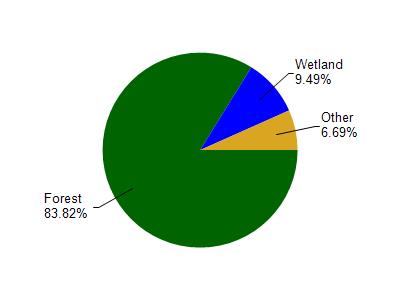Douglas
No
No
No
Fish and Aquatic Life
Overview
Loon Lake, in the Upper St. Croix and Eau Claire Rivers Watershed, is a 101.05 acre lake that falls in Douglas County. This lake is managed for fishing and swimming and is currently not considered impaired.
Date 2011
Author Aquatic Biologist
Historical Description
Source: 1973, Surface Water Resources of Douglas County Loon Lake, T45N, R10W, Section 13,
A landlocked soft water seepage lake with a littoral bottom primarily of sand, with an overlay of detritus in some areas. Muck is found in the bays and aquatic vegetation is common, especially at the south end of the lake. Pondweeds, bulrushes, and yellow pond lilies are the most common aquatic plants. The upland shore has jack pine and scrub oak. A partial winterkill of fish occurred in 1964-65 resulting in generally poor fishing. The present fishery is dominated by northern pike, pumpkinseeds, and black bullheads. There are also bluegills, perch, largemouth bass, and black crappies. The populations of the various species will probably continue to fluctuate greatly in numbers and growth depending upon winter freeze-out conditions. Extreme fluctuations of five to six feet of depth in water levels may occur. During periods of extremely high levels, runoff waters are sometimes discharged into nearby Sand Lake, as in 1954. A town road access is located at the north end of the lake and is the only public frontage. There are ten cottages on the lake. Nesting waterfowl include mallards, teal, wood ducks, and loons.
Surface Acres-108.6, Maximum Depth-20 feet, M.P.A.-40 ppm, Secchi Disk-12 feet
Date 1973
Author Surface Water Inventory Of Wisconsin
Condition
Wisconsin has over 84,000 miles of streams, 15,000 lakes and milllions of acres of wetlands. Assessing the condition of this vast amount of water is challenging. The state's water monitoring program uses a media-based, cross-program approach to analyze water condition. An updated monitoring strategy (2015-2020) is now available. Compliance with Clean Water Act fishable, swimmable standards are located in the Executive Summary of Water Condition in 2018. See also the 'monitoring and projects' tab.
Reports
Management Goals
Wisconsin's Water Quality Standards provide qualitative and quantitative goals for waters that are protective of Fishable, Swimmable conditions [Learn more]. Waters that do not meet water quality standards are considered impaired and restoration actions are planned and carried out until the water is once again fishable and swimmable
Management goals can include creation or implementation of a Total Maximum Daily Load analysis, a Nine Key Element Plan, or other restoration work, education and outreach and more. If specific recommendations exist for this water, they will be displayed below online.
Monitoring
Monitoring the condition of a river, stream, or lake includes gathering physical, chemical, biological, and habitat data. Comprehensive studies often gather all these parameters in great detail, while lighter assessment events will involve sampling physical, chemical and biological data such as macroinvertebrates. Aquatic macroinvertebrates and fish communities integrate watershed or catchment condition, providing great insight into overall ecosystem health. Chemical and habitat parameters tell researchers more about human induced problems including contaminated runoff, point source dischargers, or habitat issues that foster or limit the potential of aquatic communities to thrive in a given area. Wisconsin's Water Monitoring Strategy was recenty updated.
Grants and Management Projects
Monitoring Projects
| WBIC | Official Waterbody Name | Station ID | Station Name | Earliest Fieldwork Date | Latest Fieldwork Date | View Station | View Data |
|---|
| 2479000 | Loon Lake | 10033375 | Loon Lake - Deepest Spot | | | Map | Data |
| 2479000 | Loon Lake | 10002175 | Loon Lake | 9/5/2000 | 9/12/2017 | Map | Data |
| 2479000 | Loon Lake | 10054056 | Loon Lake - S. Loon Lake Road | 8/11/2020 | 8/11/2020 | Map | Data |
|

Watershed Characteristics
Loon Lake is located in the Upper St. Croix and Eau Claire Rivers watershed which is 277.89 mi². Land use in the watershed is primarily forest (83.90%), wetland (9.50%) and a mix of open (4.30%) and other uses (2.40%). This watershed has 153.93 stream miles, 7,654.41 lake acres and 13,694.48 wetland acres.
Nonpoint Source Characteristics
This watershed is ranked Not Ranked for runoff impacts on streams, Not Ranked for runoff impacts on lakes and Low for runoff impacts on groundwater and therefore has an overall rank of Low. This value can be used in ranking the watershed or individual waterbodies for grant funding under state and county programs.However, all waters are affected by diffuse pollutant sources regardless of initial water quality. Applications for specific runoff projects under state or county grant programs may be pursued. For more information, go to surface water program grants.